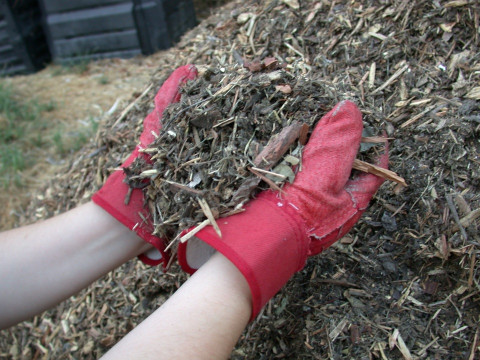Laying down mulch in garden beds may be a big task, but it pays off if used correctly. Mulching is a common practice that farmers use to suppress weeds and, in some cases, improve garden soil quality.
Below are 10 different types of mulch, along with their benefits and how to use them in the garden.
Mulching Benefits
Mulch is any protective material used to cover the soil. Below are the main benefits of using mulch in the garden:
- Keeps down weeds.
- Preserves moisture in the soil.
- Improves the condition of the soil.
- Protects the soil from compaction during extreme weather conditions.
- Keeps the ground warm.
- Prevents soil erosion.
- Restricts damage from some pests and wildlife.
- As they decompose, they impart valuable nutrients to the soil beneath.
- Enhances the attractiveness of the garden.
Overall, mulched soil leads to a healthier and more visually appealing garden.
Different Types of Mulch
There are two basic types: organic and inorganic.
Inorganic mulches, such as landscape fabric and gravel, can be used effectively but do not decompose.
Organic mulches are made from natural, biodegradable materials such as grass clippings, wood chips, and compost.
Organic mulches have more benefits for the soil, your plants, and the environment. They are preferable because they decompose naturally, adding organic matter to the soil.
Below are the most commonly used mulches among gardeners.
1. Newspaper
You can use this as a cheap, biodegradable plant mulch if you already have daily or weekly newspapers available at home.
Is it safe for gardening? Most publications now use dyes and pigments that contain organic materials for their printing [1]. For this reason, this method has gained popularity in organic gardening over the past few years.
Put down sheets of newspaper on top of the soil before wetting it. Additionally, using stones or bricks to hold the edges will protect them from blowing away.
You can also put a layer of several sheets of newspaper with organic mulch, such as grass cuttings, over them. This will help keep the papers in place.
2. Grass Clippings
Again, this is cost-effective where there is a regular supply of cut grass. However, it is best to let grass clippings dry before spreading them out.
Left too long without being forked over, they can become a slimy mat, preventing air and water from getting through.
Moreover, grass clippings decompose quickly, enriching the soil.
3. Wood Bark
Wood bark is one of the more attractive mulches and can be bought in garden stores.
Shredded bark from cedar, pine, hemlock, or spruce lasts a long time. You can often get it for free from local woodcutters.
Additionally, wood bark breaks down slowly and is one of the best types of mulch.
4. Cardboard
Use cardboard in much the same way as you would use newspaper.
It is relatively biodegradable and is most helpful in suppressing weeds and providing warmth. However, wax-coated cardboard limits water absorption and is best avoided.
Using a layer of straws or hay over the cardboard before wetting it will help keep it in place. Some farmers also use rocks to prevent it from blowing away.
5. Straw and Hay
These mulches are among the most popular and practical choices for organic vegetable gardens. They are easy to handle.
Moreover, beneficial insects enjoy the warmth and feeding opportunities that straw and hay mulches provide. They are also helpful in protecting seeds from birds and preventing them from being washed away by heavy rainfall.
To use straw mulch, place a handful between plant rows in layers three to six inches thick. However, be careful not to stifle plants—keep away from roots and leaves.
For hay, create a thick layer over garden soil.
These mulches biodegrade slowly, and you can easily find space between them when planting seedlings.
When planting seeds, remove the mulch. As the seeds germinate, replace them around your plant’s roots.
6. Shredded Leaves
This method is another way to recycle natural resources on the farm. Shredded leaves will form an attractive layer, smother weeds, and enrich the soil as they decompose.
7. Compost
The most apparent benefit of compost is the enrichment of the soil as it breaks down and leaches nutrients into the earth beneath. A layer of this will provide all the same usefulness as other mulches, plus more.
8. Pine Needles
Also known as pine straw, this lightweight, carbon-rich material is excellent for some flower beds.
If you have plenty of pine trees around, make use of the needles as they fall. Besides, the cones are beneficial as well.
9. Gravel and Small Stones
These are the most attractive inorganic types of mulch. They are permanent and valuable in driveways, around trees and shrubs, and for mulching flower beds.
Use a protective layer, like newspaper, under stones and gravel. This helps to stop weeds from growing through.
However, it provides good drainage and warmth in rock gardens, where colored stones can be particularly pleasing to the eye.
The downside is that these will not improve the condition or add nutrients to the earth below.
10. WeedGuard Plus
This commercial product from Arbico Gardening Store works differently and is safe for use in organic gardening.
The fine, paper-like material is obtained from cellulose fiber. The product is designed to cover weeds as they germinate, preventing light and stifling growth.
Furthermore, the opaque material is resistant to heavy rainfall. WeedGuard Plus is also long-lasting, high-quality, and biodegradable.
Takeaway
There are many mulch garden ideas. However, the right type can suppress weeds, protect plants from weather-related damage, and provide additional benefits.
They can help shield the soil against drought, compaction, erosion, cracking, and extremes of heat or cold. Mulching can also improve soil conditions, cover wet and muddy areas, and be an ornamental feature in the garden.
Selecting the right mulch is crucial for gardeners. It helps meet your goals and promotes healthy plants. Correctly applying it is also essential.








Add comment